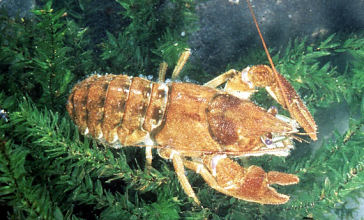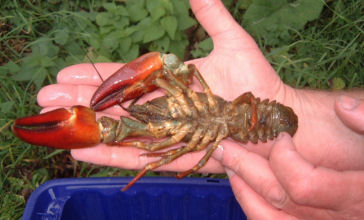The Signal Crayfish, an unwelcome intruder from the USA, was once thought to be a problem only in the southern parts of the UK. It is well known and becoming increasingly documented that this predatory species is now established much further north. In the four years or so since they were first noticed in one of our becks near Thirsk in North Yorkshire they have proliferated such that they now appear unstoppable.
 The signal crayfish (Pacifastacus leniusculus) is much larger than the native white-clawed (Austropotamobius pallipes) variety making them easily recognisable. They can reach 15cm-18cm in length.
The signal crayfish (Pacifastacus leniusculus) is much larger than the native white-clawed (Austropotamobius pallipes) variety making them easily recognisable. They can reach 15cm-18cm in length.
 Native white-clawed crayfish (Austropotamobius pallipes).
Native white-clawed crayfish (Austropotamobius pallipes).
 Signal crayfish displaying the characteristic red/orange colouring on the underside of the claws.
Signal crayfish displaying the characteristic red/orange colouring on the underside of the claws.
Signals are thought to be partly responsible for the decline in numbers of our indigenous species as they carry a disease commonly known as crayfish plague (Aphanomyces astaci) this disease kills the white-clawed variety. They are voracious feeders with catholic tastes; they will take small fish, fish eggs, and crustaceans and are cannibalistic, devouring both their own kind and white-claws. Fish and herons predate upon small signals but the adults appear to have few predators other than otters.
They are quite easily found. Smaller ones often lurk under flat stones like white-claws but larger ones and breeding females can be seen in their burrows, which they like to dig into clay banks. They are also often spotted just meandering along the riverbed. The best indications of the presence of signal crayfish are; decline in numbers of white-claws, burrows in clay banks; these are typically 4/5 cm diameter and the large claws which may be found laying on the riverbed (large ones are sometimes found with only one claw). They can travel considerable distances over land and often get into new river systems from ponds.
Management of signal crayfish is not a simple matter as they are a fish (crustaceans are considered such) their removal cannot be undertaken without section 31 consent. In some post code areas DEFRA and EA will permit removal of signals but special conditions apply e.g. traps/pot must have otter guards. Laws and byelaws are presently being reviewed and possibly challenged to permit easier control and management of these pests.
These invaders have not limited their mass colonisation to the UK either, last year I witnessed the problem in France. The L'Arzon is a tributary of the Loire and a lovely little limestone spate stream in the Massif Central, while fishing there I saw many signals one was happily walking along the riverbed with half a gudgeon in its possession. My nine-year-old son Henri stepped into a pool with his net and caught nine of them in about twenty minutes. Several conversations with the locals revealed that they had first been noticed two years previously and were now everywhere. I offer this experience as further evidence of the rapidity with which the creatures can multiply.
At York Tradesmen's Angling Association (YTAA) we would like to see further debate and research to assess what effect the presence of these intruders have on our becks and future sport. This could hopefully lead to a long-term national control strategy and help clubs with local management policy.
Footnote; if you can remove them legally (a licence is required from the Environment Agency) they are very good eating but they must be purged in clean water first. This has problems in itself, as you are not permitted to flush the water down the sink as there is a concern about escaping eggs and larvae.